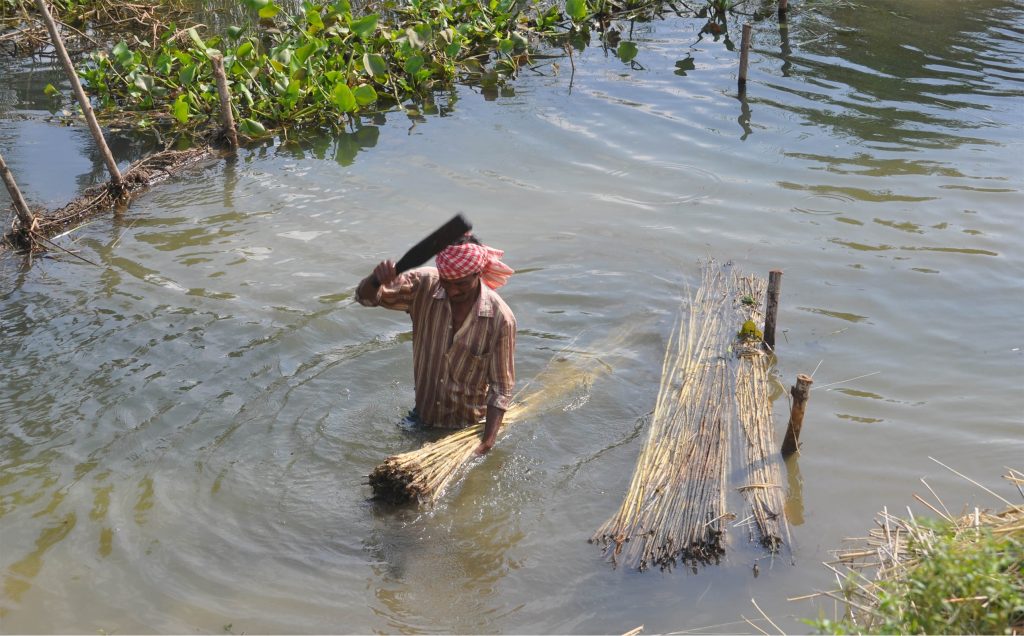Kendrapara: Kendrapara district is known for the cultivation of fibre crops. However, jute cultivation is inching towards extinction due to the apathetic attitude and negligence of the Agriculture Department. Farmers in the district were cultivating jute, mesta and sesbania (Dhanicha) crops on 2,152 hectare land in 2005. The presence of favourable climatic conditions, suitable soil and proper publicity boosted the cultivation of these crops. As a result, the cultivation expanded to 8,000 hectares of farmland by 2015. This paved the way for the establishment of a jute research centre on 46 acre land at Jajanga near the district headquarters town.
However, the research centre soon got into problems and stopped selling seeds in 2019-20. Left with no other option, farmers have been buying the seeds from the open market. However, after the seeds turned out to be of sub-standard quality, the farmers are now turning to other crops to eke out a living. Jute is a long, soft and shiny bast fibre that can be spun into coarse and strong threads. It is one of the most affordable natural fibres and second only to cotton in the volume of production and variety of use. The farmers sell jute fibre, sweet jute leaves and Kaunria sticks in the local market. However, cultivation of jute is on the wane in Kendrapara district due to a lack of proper sponsorship from the state government. This has delayed the supply of jute, mesta and sesbania seeds to the farmers. Niranjan Parida of Kansar panchayat under Kendrapara block said the soil of Kendrapara district is suitable for jute and mesta cultivation. Sesbania if sown at the same time as paddy crops helps increase soil nutrients and also brings down pest attacks on paddy crops, a farmer leader Gayadhar Dhal said adding that the farming season starts from Akshaya Tritiya but the Agriculture Department’s failure in supplying paddy and sesbania seeds to the farmers from the start of the festival is quite unfortunate.
Maheswar Sethi, a farmer of Chatarachakada village under Derabish block, said jute seeds were sold at Rs 40 per kg in 2015 while the price has now increased to Rs 90 per kg in the open market. This has come as a blow to the jute farmers. Ramamani Samal, member of a women self-help group at Paripangara village, said the Centre has banned single-use plastic since 2015. This announcement has come as a boon for artisans like her involved in jute-based cottage industries. The unit manufactures various jute-based products but the profit margin is declining as it has to pay more for purchasing the raw material from outside the state. The decline in domestic jute production due to lack of seeds has hit them hard, she said adding that jute cultivation needs to be promoted so that they can purchase the fibre at a nominal price. She demanded the state government intervene and promote jute cultivation in the district through sponsorship.
Senior citizen Banamabar Sahu said the district lacks major or small industries and agriculture is the mainstay of people. Farmers are turning away from jute cultivation due to lack of sponsorship from the state government. When contacted, district agriculture officer Manoj Chand said the Odisha Seeds Supply Corporation (OSSC) had supplied jute, mesta and sesbania seeds in 2015. Over 7,000 farmers purchased the seeds and cultivated them on their farmlands. Meanwhile, the OSSC has stopped procuring jute and mesta seeds and stopped the supply to the farmers who require 30 quintal seeds per year. However, this year they have received 120 quintal of sesbania seeds only

